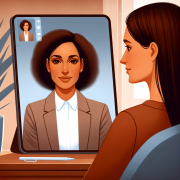Therapy for Children of Divorce: Especially if Your Child Lives With You
Therapy for Children of Divorce: Especially if Your Child Lives With You
Divorce also affects teenagers, so it’s only natural to consider therapy for children of divorce as an option. Research shows that most people, including most children, struggle because they lack the necessary resources to deal with divorce, despite the fact that it is an extremely traumatic event.
Media outlets such as newspapers, journals, and television shows regularly emphasize the long-term impact divorce causes, especially on the children of the divorcing parties. Despite making for dramatic headlines, this is not how scientific evidence works. Divorce in itself has no long-term impact on children’s mental health or academic achievement, according to research. The way in which parties treat one another as they are uncoupling can impact all ages of children whose parents are getting divorced.
Children face various problems due to divorce, but most of them can overcome them after some adjustment. Although divorce is nearly always traumatic, it does not cause permanent harm if handled appropriately.
How to Explain Divorce To Your Child
Children of various ages interpret divorce in different ways. Young children certainly have no concept of divorce, yet they do have a concept of changes in their daily routine. They value consistency and security above anything else.
Younger children and teenagers may have similar questions:
- Where will I live now?
- Will you leave me alone?
- Where will all my things be now?
- When will I see my other parent?
- Will you still love me?
Teenagers need information the most. As such, they need a brief but clear explanation. It is appropriate for children to know the reasons behind their parents’ divorce, but not all the details of their parents’ marriage. They are children, not friends.
Signs Your Child Needs Therapy After Divorce
Trauma and psychological anguish can have long-lasting effects that can drastically change a person’s life, well into adulthood. Because trauma and post-traumatic stress disorder are frequently invisible, it is important to notice this in others and suggest therapy if you can.
These are some of the things you should pay attention to:
- Atypical behavior,
- Changes in eating and/or appetite,
- Changes in daily functioning,
- Lack of interest in things they used to enjoy,
- Sudden medical issues.
Types of Therapy
Divorce may be challenging for the whole family, so it’s even more critical for all individuals to have the support they need. Fortunately, a variety of therapy services can assist in adjusting to the emotional and psychological repercussions of divorce.
Cognitive-behavioral therapy (CBT), family therapy, and trauma-focused cognitive-behavioral therapy (TF-CBT) are some of the most popular types of treatment. Depending on the circumstances, starting therapy as a family might be beneficial to show you are a family, no matter what.
The benefit of children of divorce going to therapy is coping mechanisms and an increased ability to process their emotions. Individuals benefit from therapy by having access to an objective person. A therapist can support and mentor them while they process their feelings around their parents’ divorce.
A therapist, for instance, can assist in identifying underlying problems brought on by the divorce, such as anger, anxiety, humiliation, guilt, and grief. With this knowledge, you may encourage them to express their feelings securely in a safe setting rather than suppressing or acting out inappropriately. People can better accept and get through challenging life transitions with the assistance of a qualified adult without experiencing long-term psychological issues.
Therapy for children of divorce can help mend complex concerns between parents and their children. According to research, a successful outcome in family therapy after divorce depends on parental participation. A therapist can suggest the most important ways for parents to support their children during this time. Therapists can also provide insightful advice on any possible parenting problems that must be addressed.
Collaborating with a skilled therapist ensures everyone gets the most out of the therapeutic process and lays the groundwork for long-term, healthy family interactions.
Conclusion
Much of what people believe about divorce will be different from what they are seeing. When parents provide information intended to assist their children rather than relieve themselves of responsibility or place blame on the other parent, it is easier. In all of this, the help of a skilled family therapist is valuable. They can support in ways that others cannot.
About Life Coaching and Therapy
Life Coaching and Therapy (LCAT) is a therapy and coaching practice that transforms our clients lives through our flexible. Multi-technique approach and pleasure-skills training provided by systematically-trained and licensed therapists!
 Get to know our founder and owner, Amanda Pasciucco, (a.k.a. The Sex Healer) PhD, Licensed Marriage and Family Therapist (LMFT), and an AASECT Certified Sex Therapist (CST) that has developed innovative therapy programs and therapy videos that get results.
Get to know our founder and owner, Amanda Pasciucco, (a.k.a. The Sex Healer) PhD, Licensed Marriage and Family Therapist (LMFT), and an AASECT Certified Sex Therapist (CST) that has developed innovative therapy programs and therapy videos that get results.
Our team of compassionate, licensed therapists and certified sex therapists help all clients who visit us for a variety of personal, relationship, intimacy and sex problems.
LCAT provides on-site appointments, as well as video chat and text therapy programs.
Learn more about how LCAT can help improve your life at What We Do.


























